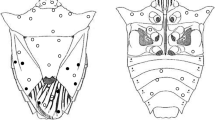Abstract
The synchrony of the citrus blackfly (CBF)Aleurocanthus woglumi Ashby and its parasitoidAmitus hesperidum Silvestri was studied in southern Florida.A. hesperidum adults emerge from 4th instar nymphs 160–300 thermal units after CBF adults. This insured excellent temporal synchronization between the parasitoids and the early CBF instars they prefer since egg to 3rd instar nymph in CBF takes 380 thermal units. AlthoughA. hesperidum parasitized only 29% of the surviving 4th instar CBF, it was the factor responsible for the observed decline in the CBF population level in southern Florida.
Résumé
La coïncidence de la mouche noire des citrus,Aleurocanthus woglumi Ashby et de son parasitoïde,Amitus hesperidum Silvestri a été étudiée en Floride mérioionale. Les imagos deA. hesperidum sortent des larves du 4e stade de l’aleurode quand il y a eu 160 à 300 unités thermiques après la sortie des aleurodes adultes. Ce phénomène assure une excellente coïncidence temporelle entre les parasitoïdes et les premiers stades de l’aleurode, qu’ils préfèrent, puisque le développement depuis l’œuf jusqu’au 3e stade de l’aleurode demande 380 unités thermiques. Bien qu’A. hesperidum parasite seulement 29% des aleurodes du 4e stade survivant, il a constitué le facteur responsable de la réduction du niveau de population de l’aleurode observé en Floride méridionale.
Similar content being viewed by others
References
Cherry, R. H. — 1979. Lethal temperatures of citrus blackflyAleurocanthus woglumi [Hom.: Aleyrodidae] and its parasite,Amitus hesperidum [Hym.: Platygasteridae]. —Entomophaga, 24, 35–39.
Dietz, H. F. & Zetek, J. — 1920. The blackfly of citrus and other tropical plants. —U.S.D.A. Bull. Tech., 885, 55 pp.
Dowell, R. V. &Fitzpatrick, G. E. — 1978. Effects of temperature on growth and survivorship of the citrus blackfly. —Can. Entomol., 110, 1347–1350.
Dowell, R. V., Reinert, J. A. &Fitzpatrick, G. E. — 1978. Development and survivorship ofAleurocanthus woglumi Ashby on six citrus hosts. —Environ. Entomol., 7, 524–525.
Enkerlin, D. W. — 1974. Some aspects of the citrus blackfly (Aleurocanthus woglumi Ashby) in Mexico. —Proc. Tall Timbers Conf. Ecol. Anim. Cont. Habitat Mgmt., 6, 65–76.
Fitzpatrick, G. E., Cherry, R. H. &Dowell, R. V. — 1978. Short-term effects of three insecticides on predators and parasites of the citrus blackfly. —Environ. Entomol., 7, 553–555.
Flanders, S. W. — 1969.Herbert Smith’s observations on citrus blackfly parasites in India and Mexico and the correlated circumstances. —Can. Entomol., 101, 467–480.
Griffiths, K. J. — 1969. The importance of coincidence in the functional and numerical responses of two parasites of the European sawfly,Neodiprion sertifer. —Can. Entomol., 101, 673–713.
Hart, W. G., Selhime, A., Harlan, D. P., Ingle, S. J., Sanchez, R. M., Rhode, R. H., Garcia, C. A., Caballero, J. &Garcia, R. L. — 1978. The introduction and establishment of parasites of citrus blackfly,Aleurocanthus woglumi in Florida. —Entomophaga, 23, 361–366.
Newell, W. &Brown, A. C. — 1939. Eradication of the citrus blackfly in Key West, Fla. —J. Econ. Entomol., 32, 680–682.
Quezada, J. R. — 1974. Biological control ofAleurocanthus woglumi [Homoptera: Aleyrodidae] in El Salvador. —Entomophaga, 19, 143–154.
Reinert, J. A. — 1976. Citrus blackfly control by foliar treatments of dooryard citrus. —Proc. Fla. State Hort. Soc., 89, 365–366.
Richardson, H. H. — 1949. Present status of the citrus blackfly and its parasiteEretmocerus serius at Nassau, Bahamas. —J. Econ. Entomol., 41, 980.
Smith, H. D., Maltby, H. L. & Jimenez, J. E. — 1964. Biological control of the citrus blackfly in Mexico. —U.S.D.A. Tech. Bull., 1311, 29 pp.
Southwood, T. R. E. — 1975. Ecological Methods. — Chapman & Hall, London, 391 pp.
Author information
Authors and Affiliations
Additional information
Florida Agricultural Experiment Station Journal Series No. 1167.
Rights and permissions
About this article
Cite this article
Dowell, R.V. Synchrony and impact ofAmitus hesperidum [Hym.: Platygasteridae] on its host,Aleurocanthus woglumi [Hym.: Aleyrodidae] in southern Florida. Entomophaga 24, 221–227 (1979). https://doi.org/10.1007/BF02374235
Issue Date:
DOI: https://doi.org/10.1007/BF02374235




